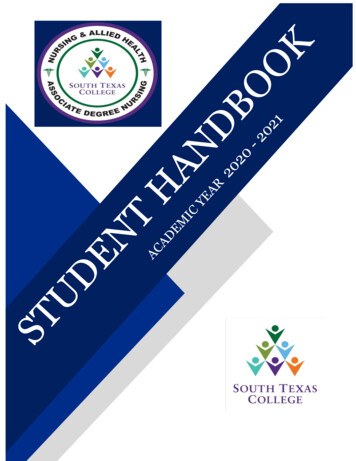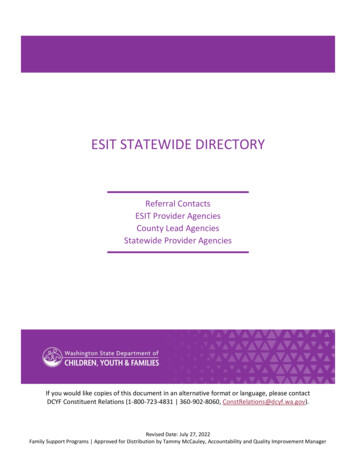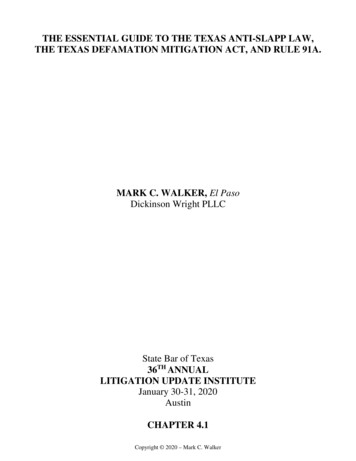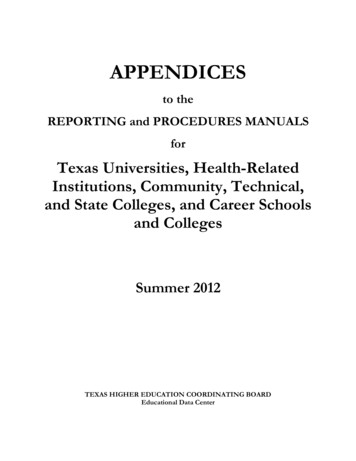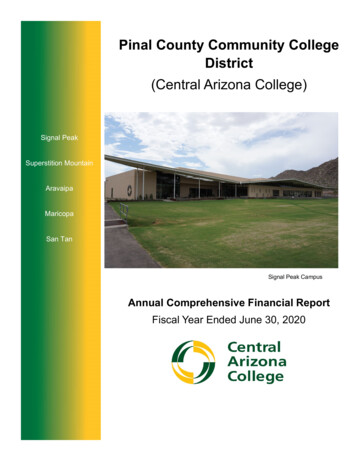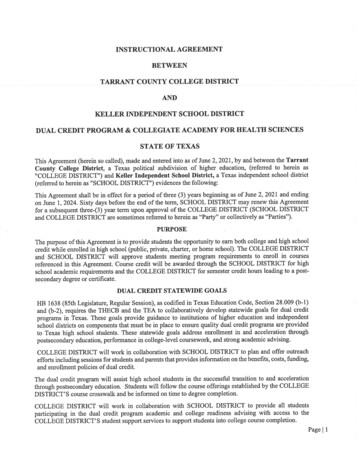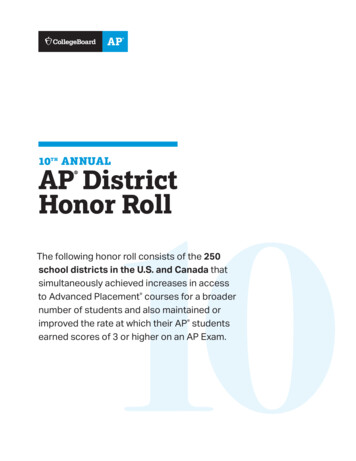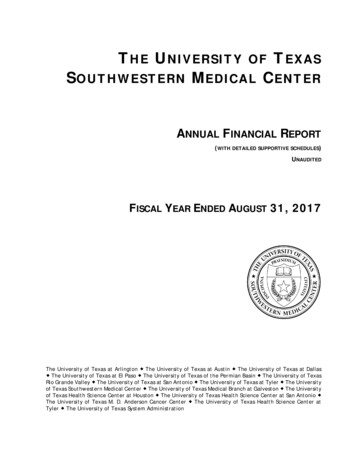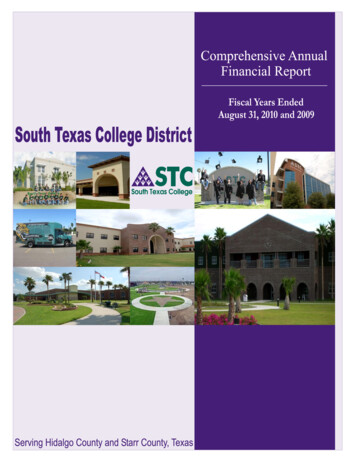
Transcription
South Texas College DistrictComprehensive Annual Financial ReportFiscal Years Ended August 31, 2010 and 2009Prepared by the Business OfficeHidalgo County and Starr County, Texas 3201 W. Pecan, McAllen, TX 78501 956.872.8311 www.southtexascollege.edu
“Get a Life.A Student Life!”IntroductorySection
South Texas College DistrictCOMPREHENSIVE ANNUAL FINANCIAL REPORTFISCAL YEARS ENDED AUGUST 31, 2010 AND 2009TABLE OF CONTENTSPage No.INTRODUCTORY SECTIONTable of Contents -------------------------------i-ivTransmittal Letter -------------------------------1-19Administrative Officers ------------------------21Board of Trustees l Chart ---------------------------24GFOA Certificate of Achievement -----------25FINANCIAL SECTIONReport of Independent Auditors ---------------27-28Management’s Discussion and Analysis -----29-46Basic Financial Statements:Exhibit 1Statements of Net Assets -----------------------48Exhibit 2Statements of Revenues, Expenses and Changes in Net Assets ----------------------------49Exhibit 3Statements of Cash Flows ----------------------50-52Notes to the Financial Statements -------------53-84i
South Texas College DistrictCOMPREHENSIVE ANNUAL FINANCIAL REPORTFISCAL YEARS ENDED AUGUST 31, 2010 AND 2009TABLE OF CONTENTS (Continued)Page No.Supplementary Information:Schedule ASchedule of Operating Revenues --------------85-86Schedule BSchedule of Operating Expenses by Object -87Schedule CSchedule of Non-Operating Revenues and Expenses ----------------------------------------88Schedule DSchedule of Net Assets by Source and Availability edule ESchedule of Expenditures of Federal Awards -97Schedule FSchedule of Expenditures of State Awards -98-99STATISTICAL SECTION (UNAUDITED)Statistical Information -------------------------101Statistical Supplement 1Net Assets by Component (Unaudited) ----- 102-103Statistical Supplement 2Revenues by Source (Unaudited) ------------ 104-107Statistical Supplement 3Program Expenses by Function (Unaudited) ------------------------------------------------- 108-111Statistical Supplement 4Tuition and Fees (Unaudited) -----------------ii112
South Texas College DistrictCOMPREHENSIVE ANNUAL FINANCIAL REPORTFISCAL YEARS ENDED AUGUST 31, 2010 AND 2009TABLE OF CONTENTS (Continued)Page No.Statistical Supplement 5Assessed Value and Taxable Assessed Value of Property (Unaudited) ------------------113Statistical Supplement 6State Appropriation Per FTSE and Contact Hour (Unaudited) ----------------------------115Statistical Supplement 7Principal Taxpayers (Unaudited) -------------- 116-119Statistical Supplement 8Property Tax Levies and Collections (Unaudited) ------------------------------------------- 120-121Statistical Supplement 9Ratios of Outstanding Debt (Unaudited) ---- 122-123Statistical Supplement 10Legal Debt Margin Information (Unaudited) ------------------------------------------------- 124-125Statistical Supplement 11Pledged Revenue Coverage (Unaudited) ----127Statistical Supplement 12Demographic and Economic Statistics – Taxing District (Unaudited) ------------------- 128-129Statistical Supplement 13Principal Employers (Unaudited) ------------130Statistical Supplement 14Faculty, Staff, and Administrators Statistics (Unaudited) -----------------------------------131Statistical Supplement 15Enrollment Details (Unaudited) -------------- 132-133Statistical Supplement 16Student Profile (Unaudited) ------------------- 134-135Statistical Supplement 17Transfers to Senior Institutions (Unaudited) iii136
South Texas College DistrictCOMPREHENSIVE ANNUAL FINANCIAL REPORTFISCAL YEARS ENDED AUGUST 31, 2010 AND 2009TABLE OF CONTENTS (Continued)Page No.Statistical Supplement 18Capital Asset Information (Unaudited) ------137Statistical Supplement 19Changes in Net Assets (Unaudited ) ---------- 138-141Statistical Supplement 20Ad Valorem Tax Rates Authorized (Unaudited) atistical Supplement 21Property Tax Rates – All Direct and Overlapping Governments (Unaudited) ----------- 144-147Statistical Supplement 22Computation of Direct and Overlapping Debt (Unaudited) --------------------------------- 148-149SPECIAL REPORTS SECTIONReport on Internal Control Over Financial Reporting and on Complianceand other Matters Based on an Audit of Financial Statements Performedin Accordance with Government Auditing Standards ---------------------------------------- 151-152Report on Compliance with Requirements Applicable to Each Federal MajorProgram and on Internal Control Over Compliance in Accordancewith OMB Circular A-133 --------------------- 153-154Report on Compliance with Requirements Applicable to Each State MajorProgram and on Internal Control Over Compliance in Accordancewith OMB Circular A-133 --------------------- 155-156Schedule of Findings and Questioned Costs – Federal and State -------------------------- 157-159Schedule of Status of Prior Year Findings – Federal and State -----------------------------160Corrective Action Plan -------------------------161iv
South Texas College DistrictTransmittal Letter3201 West Pecan Blvd.P.O. Box 9701McAllen, Texas 78502(956) 872-4646December 9, 2010To: President Shirley A. Reed, M.B.A., Ed. D.Members of the Board of Trustees andCitizens of the South Texas College District:The Comprehensive Annual Financial Report (CAFR) of South Texas College District (“theDistrict”), Counties of Hidalgo and Starr, state of Texas, for the years ended August 31, 2010and 2009, is hereby submitted. Responsibility for both the accuracy of the data and thecompleteness and fairness of the presentation, including all disclosures, rests with themanagement of the District. To the best of our knowledge and belief, the enclosed data isaccurate in all material respects and is reported in a manner designed to present fairly thefinancial position and results of operations of the District. All disclosures necessary to enablethe reader to gain an understanding of the District‟s financial activities, in relation to its mission,have been included.Management of the District is responsible for establishing and maintaining an internal controlstructure designed to protect the assets of the District, prevent loss from theft or misuse andprovide adequate accounting data to allow for the preparation of financial statements inconformity with Generally Accepted Accounting Principles. The internal control structure isdesigned to provide reasonable, but not absolute, assurance that these objectives are met.The concept of reasonable assurance recognizes that: (1) the cost of a control should not exceedthe benefits likely to be derived; and (2) the valuation of costs and benefits requires estimatesand judgments by management.State statutes require every community college to submit audited annual financial reports to theTexas Higher Education Coordinating Board by January 1st of each year.Long Chilton, LLP, Certified Public Accountants, have issued an unqualified opinion on SouthTexas College District‟s financial statements for the year ended August 31, 2010. Theindependent auditors‟ report is included in the financial section of this report.This letter of transmittal complements and should be read in conjunction with Management‟sDiscussion and Analysis which immediately follows the independent auditor‟s report and whichprovides a narrative introduction, overview and analysis of the basic financial statements.1
Comprehensive Annual Financial ReportThe South Texas College District Comprehensive Annual Financial Report (CAFR) for the fiscalyear ended August 31, 2010 was prepared by the Business Office.The District‟s Financial Statements are in compliance with GASB Statement No. 34, BasicFinancial Statements and Management Discussion and Analysis for State and LocalGovernments, and Statement No. 35, Basic Financial Statements and Management’s Discussionand Analysis for Public Colleges and Universities. The financial statement presentation requiredby GASB Statements No. 34 and No. 35 provides a comprehensive, entity-wide perspective ofthe District‟s assets, liabilities, net assets, revenues, expenses, changes in net assets and cashflows and replaces the fund-group perspective previously required.The District maintains its accounts and prepares its financial statements in accordance withgenerally accepted accounting principles in the United States of America (GAAP) as set forth byGovernmental and Financial Accounting Standards Boards (GASB and FASB), NationalAssociation of College and University Business Officers (NACUBO) and the Texas HigherEducation Coordinating Board (THECB). The financial records of the District are maintained onthe accrual basis of accounting, whereby all revenues are recorded when earned and all expensesare recorded when incurred.The District‟s financial statements are prepared using the economic resources measurementfocus. The notes to the financial statements expand on and explain the financial statements andthe accounting principles applied.Profile of the DistrictSouth Texas College District is a political subdivision of the state of Texas located in Hidalgoand Starr Counties. The District offers academic, general occupational, developmental andcontinuing adult education programs through a network of locations in Hidalgo and StarrCounties. South Texas College District is accredited by the Commission on Colleges of theSouthern Association of Colleges and Schools to award the Baccalaureate and Associate degrees.Contact the Commission on Colleges at 1866 Southern Lane, Decatur, Georgia 30033-4097 orcall 404-679-4500 for questions about the accreditation of South Texas College District. TheDistrict also offers certificates and institutional awards. It is also approved for veteran‟seducational training in Certificate and Associate of Applied Science degree programs by theTexas Education Agency. South Texas College District‟s offerings are approved by the TexasHigher Education Coordinating Board.The District was created on September 1, 1993, by Texas Senate Bill 251, now codified asSection 130.0311, as amended, Texas Education Code, to serve Hidalgo and Starr Counties. It isthe only community college in Texas to have been established prior to a taxing district beingapproved by local voters. A confirmation election, held on August 12, 1995, established a taxingdistrict. Seven districts, based on population, were also approved for single memberrepresentation on the Board of Trustees. A community leader, from each of the seven districts,was originally appointed by the Texas Governor to serve on the founding Board of Trustees.2
Since then, elections have been held for all of the seats, as required by state law, and all memberswere elected by the year 2000. The Board of Trustees serves staggered six-year terms withelections held in May of each even-numbered year. Policy making functions are theresponsibility of, and are vested in, the Board. The Board delegates administrativeresponsibilities to the President, who is the Chief Executive Officer of the District.The District‟s Board of Trustees voted unanimously at its June 24, 2004 meeting to change thename of the college from South Texas Community College to South Texas College District toreflect the expanded scope and mission of the District.South Texas College District has five campuses conveniently located throughout Hidalgo andStarr Counties. The five campuses are as follows: (1) the Pecan Campus, (2) the TechnologyCampus, (3) the Dr. Ramiro R. Casso Nursing and Allied Health Campus, (4) the Starr CountyCampus, and (5) the Mid-Valley Campus. The Pecan Campus in McAllen, the Mid-ValleyCampus in Weslaco and Starr County Campus in Rio Grande City offer traditional collegeprograms. The Dr. Ramiro R. Casso Nursing and Allied Health Campus and the TechnologyCampus in McAllen provide specialized training for students entering the workforce. Inaddition, South Texas College District has Workforce Training Centers at the TechnologyCampus, the Mid-Valley and Starr County campuses. Faculty and staff of more than 1,800 serveSouth Texas College District‟s five campuses.3
South Texas College District is located in the Rio Grande Valley of Texas, near the southernmostpart of Texas along the US-Mexico border. This region is composed of four counties includingHidalgo, Cameron, Starr and Willacy. The South Texas College District is composed of HidalgoCounty and Starr County.HIDALGOCOUNTYSTARRCOUNTYThe Vision, Purpose, Core Values, Guiding Principles, and Strategic Directions constitute theComprehensive Mission for South Texas College, as follows:VisionA better quality of life for our communities.PurposeSouth Texas College is a world-class comprehensive institution of higher learning providingpremier educational and workforce programs and services in response to the needs of the region.Core ValuesStudent Success, Learning, Excellence, Integrity, Community, Opportunity.Guiding PrinciplesBe a premier learning-centered higher education institution where student and communitysuccess are paramount;Serve as the cornerstone for the economic vitality of South Texas;Foster an environment for the students and community to achieve a better quality of life;Nurture a culture where collaboration is valued and achievement is recognized.4
Strategic DirectionsSouth Texas College commits to student learning as the foundation of student successthrough excellence in teaching and service, faculty and staff empowerment, professionaldevelopment, and accountability.South Texas College proudly provides opportunities to all students with highexpectations for their success.South Texas College leads the transformation of the region to a “college-going” culturewhereby attending and completing higher education is expected for all.South Texas College serves as the catalyst for regional economic prosperity and socialmobility.South Texas College models professionalism through integrity, mutual respect, civility,trust, and collaboration.South Texas College champions a culture of excellence based on evidence.South Texas College District has experienced continuous growth since its inception in the Fall of1993. According to Texas Higher Education Coordinating Board, Texas added 113,770 students,an increase of 9 percent to 1.3 million students from Fall 2008. About 75 percent of that boost isattributed to community colleges, which enroll more than half of all college students in Texas.South Texas College District had a 23.5 percent increase in headcount enrollment from Fall,fiscal year 2009 to Fall, fiscal year 2010.The following tables and graphs illustrate the District‟s enrollment data over the last five years.FALL SEMESTER ENROLLMENTFY 2006 FY 2007 FY 2008 FY 2009 FY icHeadcountFull-time 6614,91326,36818,599Continuing EducationHeadcountFull-time 465
Fall Semester EnrollmentTotal Academic and Continuing Education 120,00021,65715,00010,0005,000Fall 2005Fall 2006Fall 2007Fall 2008Fall 2009ANNUAL ENROLLMENT - ACADEMICFY 2006Unduplicated credit hoursUnduplicated contact hoursUnduplicated full-timeequivalentFY 2007FY 2008FY 30,79636,169Unduplicated 1,6487,777,9846,866,3847,182,496FY 2006FY 20076,000,0004,000,0002,000,000FY 20086FY 2009537,7348,791,648 10,977,072Unduplicated Contact Hours8,000,000FY 2010FY 2010
Annual Unduplicated 3FY 2006FY 200727,94030,796FY 2008FY 200920,00015,00010,0005,000FY 2010In fiscal year 2003, the District received approval from the Texas Higher Education CoordinatingBoard to be one of three community colleges in Texas to grant baccalaureate degrees in appliedscience and applied technology. On December 7, 2004, South Texas College District wasapproved as a Level II bachelor degree granting institution by the Commission on Colleges ofthe Southern Association of Colleges and Schools, and began offering the Bachelor of AppliedTechnology in Technology Management in Fall of 2005.Today the District is the only community college in Texas accredited to offer two Bachelor ofApplied Technology (BAT) degrees, a Bachelor‟s of Applied Technology in TechnologyManagement and a Bachelor‟s of Applied Technology in Computer and InformationTechnologies.South Texas College District has more than 60 articulation agreements in place with collegesacross the country. During fiscal year 2010, South Texas College District and the Texas A&MUniversity Irma Rangel College of Pharmacy, teamed up to prepare more pharmacists to meet agrowing demand. The two institutions signed an agreement which would ensure that any SouthTexas College District student who earns the District‟s Associate of Science, Field of Study PrePharmacy degree, will be guaranteed that all of their courses will transfer to the Rangel Collegeof Pharmacy following admission. The District launched its Pre-Pharmacy Program in Fall2009.South Texas College District has developed two intensive academic programs for studentsinterested in pursuing degrees in the medical and engineering fields. The Dual EnrollmentMedical Science Academy and the Dual Enrollment Engineering Academy consist ofconcentrated two-year programs of study and internship opportunities for qualified students topursue an Associate of Science degree during their junior and senior years of high school. SouthTexas College District also offers dual enrollment programs with 52 high schools throughoutHidalgo and Starr Counties. Approximately 7,600 students enrolled in the program during theSpring 2010 semester.7
The Continuing, Professional and Workforce (CPWE) Education program provides opportunitiesfor lifelong learners to upgrade their skills, change careers or seek personal enrichment. TheCPWE Division has programs on a variety of topics including an Alternative TeachingCertificate Program, GED training and continuing professional development courses in HumanResources and Grant Writing.South Texas College District is one of the few community colleges in Texas to offer CertificatePrograms and Associate Degrees completely online. South Texas College District offers elevenonline Associate Degrees in the following fields: Interdisciplinary Studies, Secondary Education,Anthropology, Psychology, Social Work, Sociology, Business Administration, Criminal Justice,Cultural Studies-English/Spanish Translation and Cultural Studies-Spanish.South Texas College District‟s Mid-Valley Campus Child Development Center has earnedaccreditation from the National Accreditation Commission for Early Care and EducationPrograms (NAC), in just its third year of operation. This facility is the only one in the RioGrande Valley to have earned this prestigious accreditation. The accreditation process includeda self-study in which District administrators and staff, as well as parents, evaluated the programin accordance with NAC standards. After the self-study process was complete, an onsiteobservation took place at the Center by the early childhood professional accreditationassociation. National commissioners assessed the information provided by the District‟s centerand the onsite observer to determine worthiness for earning the accreditation. Only 47 otherchild care and day care facilities in Texas have earned the accreditation.With a total of approximately 746 full-time and adjunct instructors, South Texas CollegeDistrict‟s faculty is among the most qualified at any community college in the nation. There are571 faculty members with master‟s degrees, 49 hold double master‟s, 126 have doctoratedegrees, and 1 holds a double doctorate degree. In certificate and other programs, there are 135faculty members holding bachelor degrees, 1 double bachelor degree, 63 with associate degrees,3 double associate degrees, and 4 with certificates.Local EconomyLocated near the Texas-Mexico border, South Texas College District serves Hidalgo and StarrCounties. Starr County was formed in 1848 out of Nueces County. It covers approximately1,223 square miles with a 2010 estimated population of 67,521. Hidalgo County was formed in1852 from portions of Cameron and Starr Counties. It covers approximately 1,583 square mileswith an estimated population of 814,214 in 2010. Both counties are located in the Rio GrandeValley of South Texas and border the Republic of Mexico, served by 9 international bridges.Although the South Texas border region has not been completely immune to the recentrecession, the region demonstrates a well-balanced local economy that should remain strong intothe next year and likely beyond. Employment growth has happened even during the recession.The area has been luring companies with low business costs, which has fueled employmentgrowth numbers and helped increase population. As a result of population growth of gainfullyemployed citizens, the service-based industry, which has taken such a hit elsewhere, continues to8
prosper while other economic indicators are declining. The unemployment rate had a minimalincrease in both counties, however, the sales tax revenue increased in both counties.The unemployment rate for Hidalgo County increased from 11.6% in 2009 to 12.1% in2010.The unemployment rate for Starr County increased from 17.8% in 2009 to 17.9% in2010.Building permits in the major cities of the district increased 32.1% from 2009 to 2010.Per capita income in Hidalgo County increased from 12,009 in 2009 to 12,119 in 2010.Per capita income in Starr County increased from 7,980 in 2009 to 8,072 in 2010.Sales tax receipts in Hidalgo County increased 1.7% from 2009 to 2010.Sales tax receipts in Starr County increased 4.8% from 2009 to 2010.South Texas is one of the fastest growing areas in the Unites States. The region is currently thethird largest market in Texas, the 23rd largest market in the country and the largest U.S./Mexicoborder region in America. McAllen was ranked as the most competitive city in the United Statesand Canada based on the low cost of business by KPMG. McAllen allows companies to have astrategic global location and direct access to the North American and Latin American markets.Additional data related to some of the major cities in the District and surrounding communitiesinclude the following:According to the MetroMonitor released by Brookings Institute, McAllen has made thetop 20 list for Recession-Proof Cities and also ranked 11th in the United States for beatingthe recession. The report indicates: “Of all the cities in the ranking, McAllen hasexperienced the longest period of job growth, gaining jobs over the last four quarters.” InJuly 2010, McAllen was one of only 16 metros in the United States that surpassedemployment totals from the past five years. McAllen increased its job totals by 2percent, according to the analysis.(Source: McAllen Economic Development Corporation)Forbes recognized McAllen as one of the Best Places for Business and Careers in 2010.Areas were ranked on 12 metrics including business and living costs, job growth, incomegrowth, educational attainment and projected economic growth. Quality of life was alsofactored in with issues like crime, cultural and recreational opportunities.(Source: forbes.com)McAllen-Edinburg-Mission MSA made the list in the 2010 Milken Institute BestPerforming Cities Index. McAllen ranked fourth in the top 10 list based on the ability tocreate and sustain jobs and economic growth. The Milken Institute rankings are based ona variety of factors, two of which include job and salary growth trends.(Sources: milkeninsitute.org and edinburgedc.com)McAllen was in the top pick for America‟s Best Housing Markets for Investors,according to a Forbes publication in 2010. Raleigh, North Carolina, McAllen, Texas andAustin, Texas led the top 10 list for having a strong pre-recession population growth,9
slowing home price drops and a mix of jobs that‟s weighted toward growth industries likegovernment and education. (Source: forbes.com)McAllen made the top of the list of being one of several metro areas that saw significantjob growth in 2010. Business Week and Moody‟s Economy teamed up to identifyAmerica‟s 25 next recovering job markets with McAllen topping the list at number 3.These metros were ranked based on Economy.com‟s projected job growth in the firstthree months of 2010. Tourism, retail, and hospitality are expected to make a comebackas the economy improves. (Source: BusinessWeek.com)A recent report by Kiplinger, ranks McAllen No. 4 as the least expensive city to live in.The report is based on the ACCRA Cost of Living Index and measured relative pricelevels for housing, utilities, transportation, grocery items, health care and miscellaneousgoods and services.(Sources: McAllen Economic Development Corporation and Kiplinger)Fitch Ratings assigns an „AA ‟ rating for McAllen, Texas. The city‟s sound financialmanagement practices and policies have enabled it to maintain solid fund balancereserves. Dependence upon economically sensitive sales tax revenues, particularly fromthe retail sector, including the activity generated by shoppers from Mexico, issubstantially mitigated by strong fund balances and a relatively low property tax rate.Commercial trade with Mexico and health care are sectors both locally and within theregion that have grown to diversify the historically agricultural and tourism-basedeconomy. (Source: McAllen Economic Development Corporation)McAllen MSA ranks in the top 20 for the most Secure U.S. Places to Live. This rankingfrom Farmers Insurance Group of Companies augments the reality that McAllen, Texas isa great place to live and invest. The rankings took into consideration crime statistics,extreme weather, risk of natural disasters, housing depreciation, foreclosures, air quality,terrorist threats, environmental hazards, life expectancy and job loss numbers in 379 U.S.municipalities.(Sources: insurancejournal.com and McAllen Economic Development Corporation)RelocateAmerica ranks McAllen as one of the top 10 cities to live in 2010.Economically, McAllen has one of the most stable and fastest growing local economiesin the Unites States with job growth. Relocate America focused on communities poisedfor recovery and future growth. McAllen is a viable, industrious, hard workingcommunity with good employment, affordable housing and excellent future potential.(Sources: relocateamerica.com and mcallenrealestate.com)In the bi-national metropolitan area, McAllen retailers serve a market population of 1.8million. McAllen is represented by 40 of America‟s top 100 retailers and is ranked 3 rd inTexas in per capita sales tax receipts. La Plaza Mall is one of the most prosperous andhighest trafficked centers in the United States, boasting average sales of over 650 persquare foot. Many national retailers located here are among the most profitable stores intheir chains. The mall is known to generate more than 18 million visitors annually.(Sources: mcallen.org, imagesmcallen.com, and relocateamerica.com)10
Reynosa, Tamaulipas, Mexico, McAllen's twin city, and a principal city along the UnitedStates - Mexico border is a dynamic and business-oriented city with a current populationof approximately 1.2 million. These two interdependent communities are joined by threeinternational bridges that allow economic and cultural exchanges on a daily basis.Reynosa has a diverse economic base which includes oil and natural gas resources,livestock, agriculture, tourist trade and industry. This city is the fastest growing city inthe state of Tamaulipas and is the 5th fastest growing city in Mexico.(Sources: missioneda.com, mcallen.org, and pharredc.com)The Anzalduas International Bridge at Granjeno, Texas officially opened for traffic onDecember 15, 2009, becoming the state‟s 24th border crossing with Mexico and the fifthin Hidalgo County. This highly anticipated opening of the bridge has come after nearly17 years of work and forging of a strong partnership between the cities of McAllen,Mission, Hidalgo and Granjeno. The new bridge serves
South Texas College District has five campuses conveniently located throughout Hidalgo and Starr Counties. The five campuses are as follows: (1) the Pecan Campus, (2) the Technology Campus, (3) the Dr. Ramiro R. Casso Nursing and Allied Health Campus, (4) the Starr County Campus, and (5) the Mid-Valley Campus.

